

Zitierweise / cite as:
Payer, Alois <1944 - >: Chronik Thailands = กาลานุกรมสยามประเทศไทย. -- Chronik 1864 (Rama IV.). -- Fassung vom 2016-11-28. -- URL: http://www.payer.de/thailandchronik/chronik1864.htm
Erstmals publiziert: 2013-07-11
Überarbeitungen: 2015-11-28 [Ergänzungen] ; 2015-12-30 [Ergänzungen] ; 2015-08-23 [Ergänzungen] ; 2015-05-06 [Ergänzungen] ; 2015-02-21 [Ergänzungen] ; 2014-12-17 [Ergänzungen] ; 2014-12-03 [Ergänzungen] ; 2014-10-26 [Ergänzungen] ; 2014-03-01 [Ergänzungen] ; 2013-10-20 [Ergänzungen] ; 2013-10-15 [Ergänzungen] ; 2013-10-02 [Ergänzungen] ; 2013-09-14 [Ergänzungen]
©opyright: Dieser Text steht der Allgemeinheit zur Verfügung. Eine Verwertung in Publikationen, die über übliche Zitate hinausgeht, bedarf der ausdrücklichen Genehmigung des Herausgebers.
Dieser Text ist Teil der Abteilung
Thailand von
Tüpfli's Global Village Library
ช้างตายทั้งตัวเอาใบบัวปิดไม่มิด
|
Gewidmet meiner lieben Frau Margarete Payer die seit unserem ersten Besuch in Thailand 1974 mit mir die Liebe zu den und die Sorge um die Bewohner Thailands teilt. |
|
Bei thailändischen Statistiken muss man mit allen Fehlerquellen rechnen, die in folgendem Werk beschrieben sind:
Die Statistikdiagramme geben also meistens eher qualitative als korrekte quantitative Beziehungen wieder.
|
1864
Abb.: Bangkok, 1864
1864

In der Nähe Bangkoks wird ein weißer Elefant gefangen.
Abb.: Chao Phraya Prabtraichak (เจ้าพระยาปราบไตรจักร), ein weißer Elefant König Mongkuts, nach 1868
1864

Der Bangkok Calendar korrigiert die statistischen Angaben, die er im Vorjahr zum Harem des Zweiten Königs gemacht hatte:
""His Majesty the First King appears not to have been well pleased that the Editor of the Bangkok Calendar should have represented him, in the number for 1863, as having more wives than his brother the Second King. The statement was made according to a MSS said to have been prepared for the press under the direct supervision of the King himself. Indeed much of it was in his own handwriting, particularly that part relating to the Second King’s family. But it seems that the Editor misunderstood a sentence or two of the statement, and hence, soon after the issue of the Calendar for 1863, His Majesty was pleased to make the following correction of it— "What number of the Second King’s wives given here as 5 Siamese and 20 Laos, is only those that are the most-beloved to him at the present days. Those 25 wives accompanied him always to Seetha [Ban Sritha]. In fact his Laos wives more than 60, his Siamese wives more than 60. For instance on the year of enthronement, he has 48 wives accompanied him to Second King’s Palace. Since that time his wives increased every year. He endeavor always to obtain wives especially from the Laos. Now he has 120 wives at least."
And again the irrepressible Reverend Dr. Bradley added his own comments:
"Does it not show a great stride towards reform in that most pernicious sentiment, that the honour and glory of princes is enhanced by the number of their wives? Do not the few lines of His Majesty evince a desire on his part to be published in the Calendar as being in advance of his brother in reformatory efforts against the sentiment that polygamy is honourable?""
[Zitiert in: Moffat, Abbot Low <1901 - 1996>: Mongkut, the king of Siam. -- Ithaca N.Y. : Cornell UP, 1961. -- S. 135f.]
1864

Der Bangkok Calendar über die Nebenfrauen ("นางห้าม" - Haremsdamen) des Königs:
"When the king would obtain a nāṅ hām [นางห้าม] (that is one inferior to a queen) he does not send a delegation to request her from the family of a prince of equal rank with himself ; nor does he make a wedding for her, and erect buildings for her abode and pleasure, as the common people do. Sometimes he sees the girl with his own eyes, and sometimes another person brings him a report, that in such a family is a beautiful girl, whose father and mother were formerly connected with noble stock. [Evidently an allusion to the fact that titles of royalty cease at the fifth generation.] The king, if he be taken with the account given of her, sends a messenger to beg that he may be allowed to conduct her to the royal palace, to have her schooled and trained, and then inaugurated as a nāṅ hām [นางห้าม]. Sometimes the parents of a girl, thinking it would be a great good to have the king for a family prop as a son-in-law, are pleased to make an offering of their handsomest daughter, or grandchild, or niece, to the prince as the honourable station of a royal concubine. This is quite a common way or mode by which the king obtains his many wives. Again, another prolific source of the royal concubines, is the custom, when a prince has ascended the throne, and become established in his reign, that all his nobles and lords, even down to the khuns [ขุน]and hmu'ns [หมื่น], present each his most beautiful daughter or niece to the king, for the purpose of having her serve him as a nāṅ hām [นางห้าม]. In consequence of this custom, the royal concubines of the kings of Siam have ever been very numerous, numbering many hundreds, and even a thousand and upward to each." [Zitiert in: Wales, H. G. Quaritch (Horace Geoffrey Quaritch) <1900 - 1981>: Siamese state ceremonies : their history and function. -- London : Quaritch, 1931. -- 326 S. : Ill. ; 25 cm. -- S. 49]
1864


Rama IV. an Somdet Chaophraya Borommaha Si Suriyawong (สมเด็จเจ้าพระยาบรมมหาศรีสุริยวงศ์ aka. Chuang Bunnag - ช่วง บุนนาค, 1808 - 1883):
"I think that now is the chance for Britain to put into practice her policy of bringing Siam under her protection, since Siam is being harassed on one side, with the British colony on the other ... it is for us to decide what we are going to do, whether to swim up the river to make friends with the crocodile or to swim out to sea and hang on to the whale ... supposing we were to discover a gold-mine in our country ... enough to pay for the cost of a hundred warships and all the armaments from their countries ... they can always stop the sale of them when they feel we are arming ourselves beyond our station. The only weapons that will be of real use to us in the future will be our mouths and our hearts constituted so as to be full of sense and wisdom for the better protection of ourselves." [Zitiert in: Mackay, Colin <1936 - >: A history of Phuket and the surrounding region. -- Bangkok : White Lotus, 2013. -- 438 S. : Ill. ; 25 cm. -- ISBN 978-974-480-195-1. -- S. 290f.]
1864 - 1872

Ferdinand-Aimé-Augustin-Joseph Dupond (1809 - 1872) ist katholischer Apostolischer Vikar für Ost-Siam. 1865 wird er zum Bischof geweiht. Er nimmt am Ersten Vatikanischen Konzil (1869/70) teil.
1864

Der erste US-Baptisten-Missionar kommt nach Chiang Mai (เชียงใหม่): Dr. David Webster. Er kommt aus Moulmein (Mawlamyine - မော်လမြိုင်မြို့ , Burma). Er hat gehört, dass einige Kayah (ကယား) in Nord-Thailand am Christentum interessiert seien. Er bleibt zwei Jahre und muss dann aus Gesundheitsgründen in die USA zurückkehren.
1864
J. H. Chandler gibt die englischsprachige Wochenzeitung Bangkok Times heraus. Nach zwei Jahren wird das Erscheinen eingestellt, da der Eigentümer, Herausgeber und Manager in einen Rechtstreit verwickelt wurde.
1864



In Bangkok ankern insgesamt 44 Hamburger und 28 Bremer und 1 Lübecker Schiff. Es sind vorwiegend Schiffe auf Trampfahrt (nicht an feste Linien gebundene Frachtschifffahrt).
1856

Shanghai (上海) meldet die Ankunft und Abfahrt von 6 siamesischen Handelsschiffen.
Abb.: Lage von Shanghai (上海)
[Bildquelle: OpenStreetMap. -- Creative Commons Lizenz (Namensnennung, share alike)]
1864
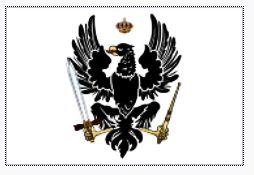
Preußen ernennt den Kaufmann Paul Lessler zum interimistischen Konsul, 1867 erhält er den endgültigen Titel eines preußischen Konsuls.
1864

Es erscheint:
Mouhot, Henri <1826-1861>: Travels in the central parts of Indo-China (Siam), Cambodia, and Laos, during the years 1858, 1859, and 1860. -- London : Murray, 1864. -- 2 Bde. : Ill. ; 23 cm. -- Originaltitel: Voyage dans les royaumes de Siam, de Cambodge, de Laos (1868!)
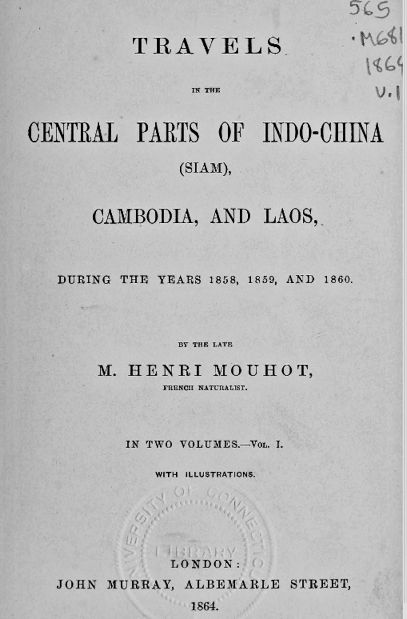
Abb.: Titelblatt
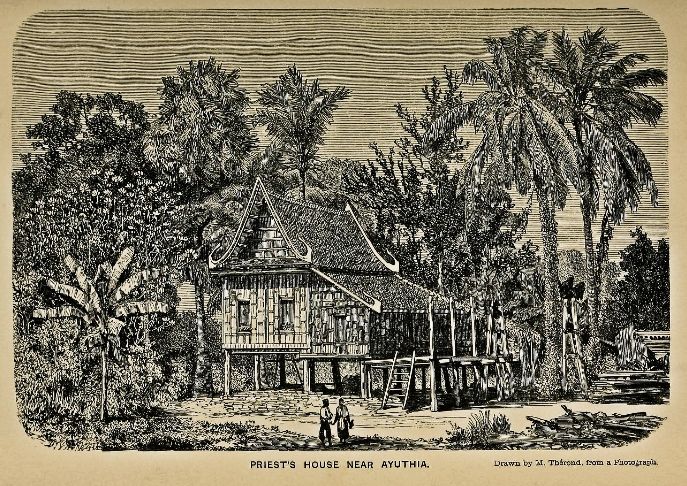
Abb.:
Mönchwohnung (กุฏิ) bei Ayutthaya (อยุธยา)
[a.a.O., Bd. 1, S. 87]
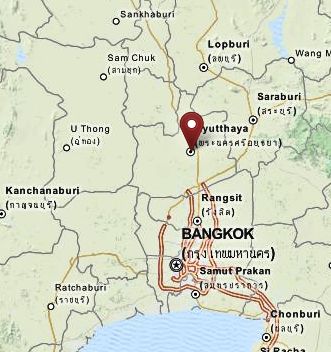
Abb.: Lage von Ayutthaya
(อยุธยา)
[Bildquelle: OpenStreetMap. --
Creative
Commons Lizenz (Namensnennung, share alike)]
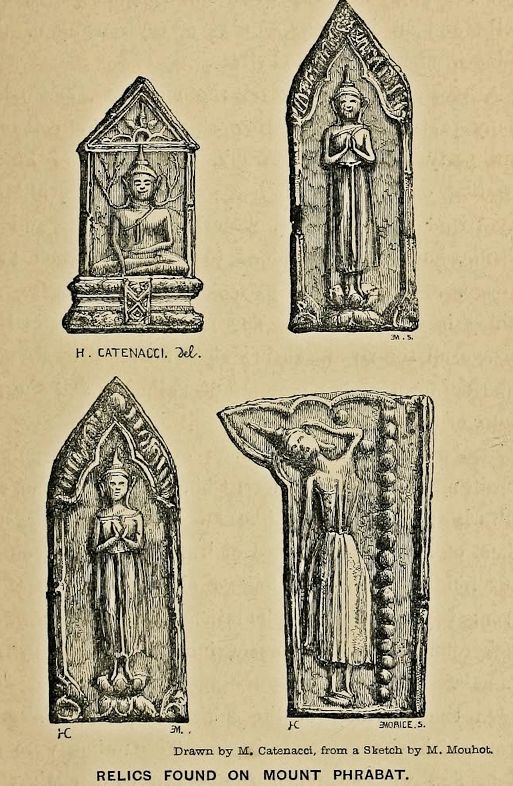
Abb.:
Votivtäfelchen (พระ) von Phra Phuttabat (วัดพระพุทธบาท)
[a.a.O., Bd. I, S. 119]
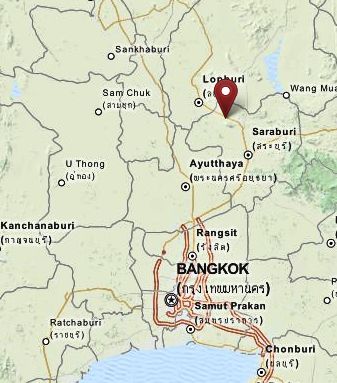
Abb.: Lage von Phra
Phuttabat (วัดพระพุทธบาท)
[Bildquelle: OpenStreetMap. --
Creative
Commons Lizenz (Namensnennung, share alike)]
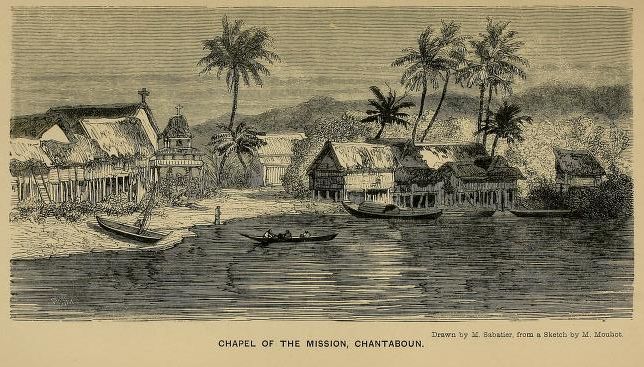
Abb.:
Missionskapelle in Chanthaburi (จันทบุรี)
[a.a.O., Bd. I]
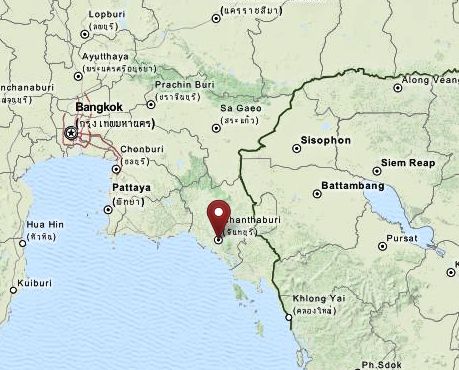
Abb.: Lage von Chanthaburi
(จันทบุรี)
[Bildquelle: OpenStreetMap. --
Creative
Commons Lizenz (Namensnennung, share alike)]
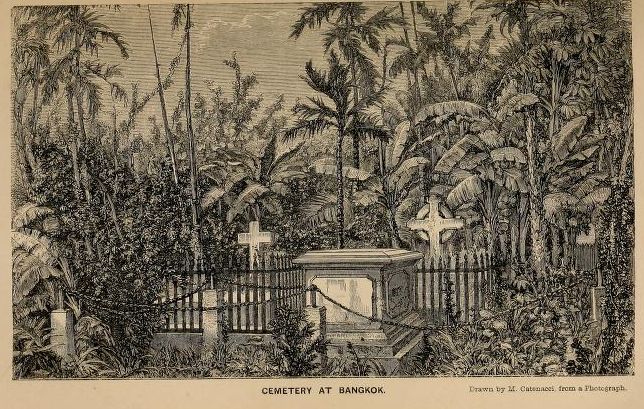
Abb.:
Protestantischer Friedhof in Bangkok
[a.a.O., Bd. II, S. 103]
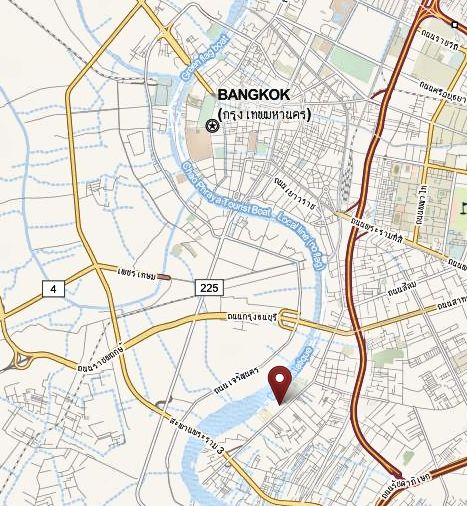
Abb.: Lage des
protestantischen Friedhofs in Bangkok
[Bildquelle: OpenStreetMap. --
Creative
Commons Lizenz (Namensnennung, share alike)]
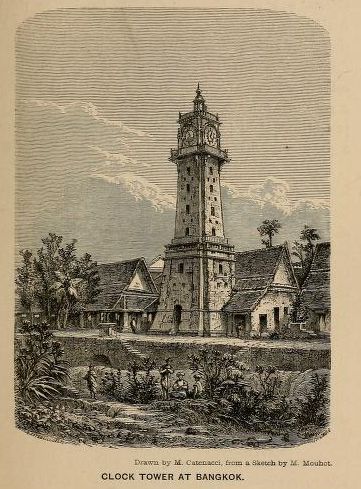
Abb.: Uhrturm in
Bangkok
[a.a.O., Bd. II., S. 65]
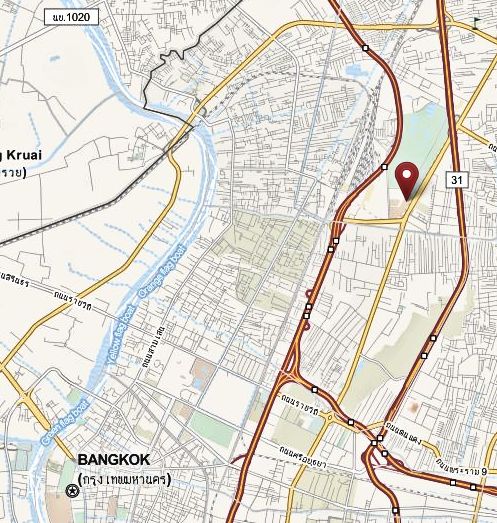
Abb.: Lage des
Uhrturms in Bangkok
[Bildquelle: OpenStreetMap. --
Creative
Commons Lizenz (Namensnennung, share alike)]
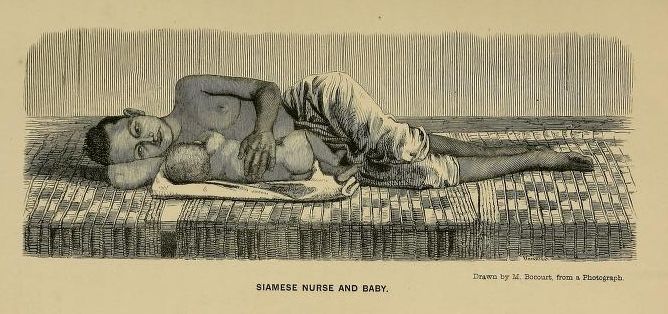
Abb.: Amme
[a.a.O., Bd. I., S. 133]
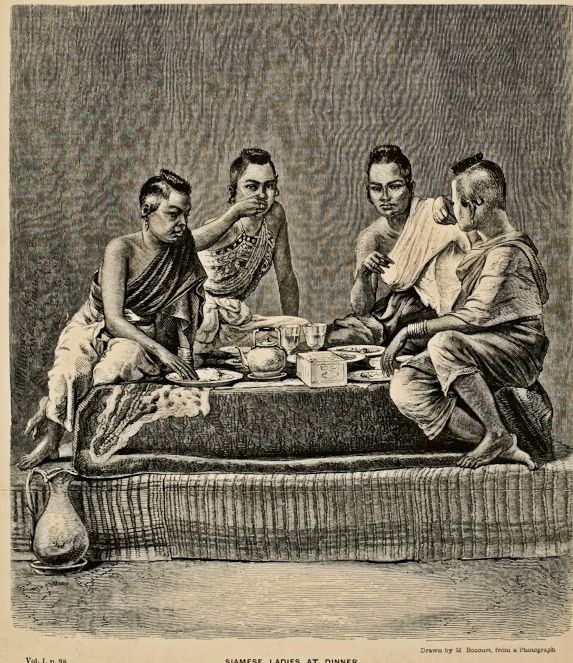
Abb.:
Siamesinnen beim Essen
[a.a.O., Bd. I., S. 99]
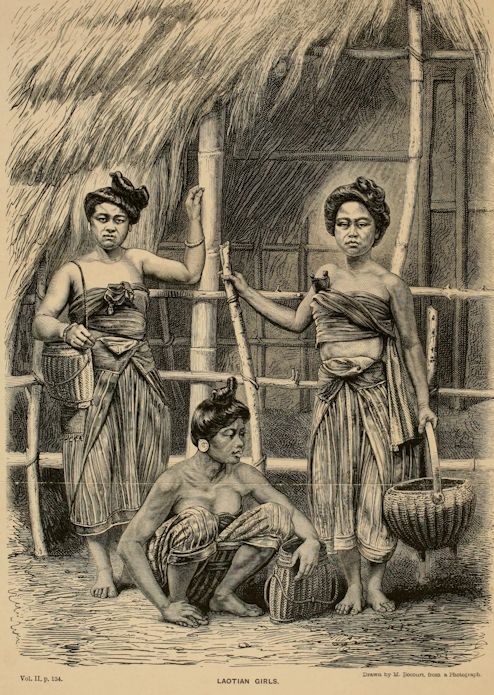
Abb.: Laotinnen
[a.a.O., Bd. II, nach S. 134]
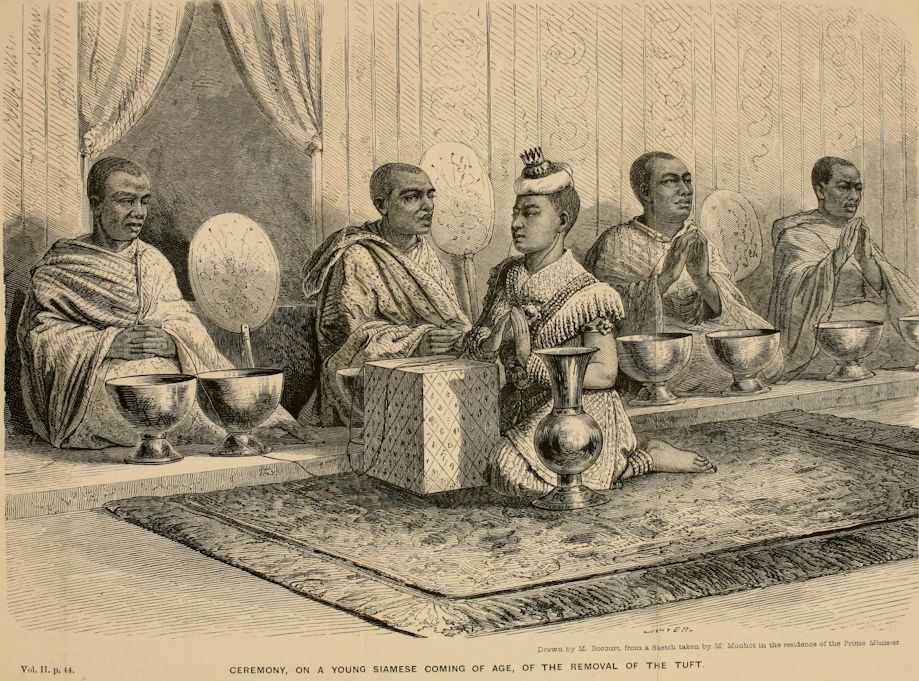
Abb.: Haarknoten-Abschneidezeremonie
[a.a.O., Bd. II, nach S. 44]
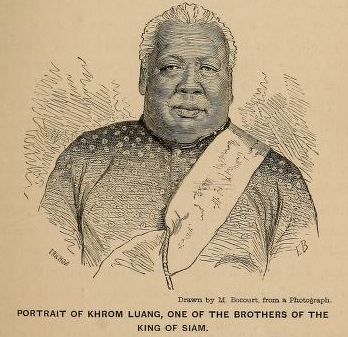
Abb.: Ein Krom Luang
(กรมหลวง)
[a.a.O., Bd. II, S. 49]
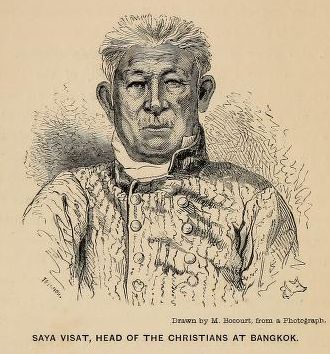
Abb.: Saya Visat,
Oberchrist von Bangkok
[a.a.O., Bd. II, S. 78]
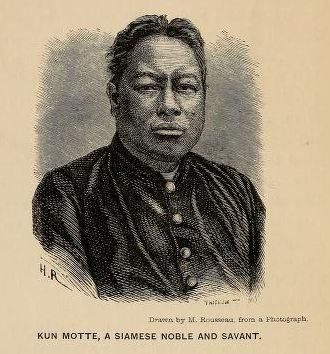
Abb.: Kun Motte,
ein adliger Gelehrter
[a.a.O., Bd. II, S. 74]
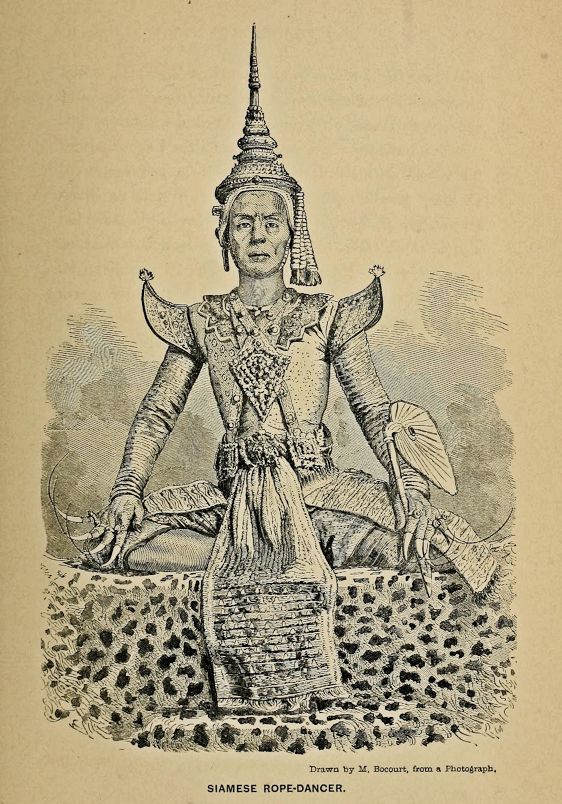
Abb.: Tänzer
[a.a.O., Bd. I, S. 100]
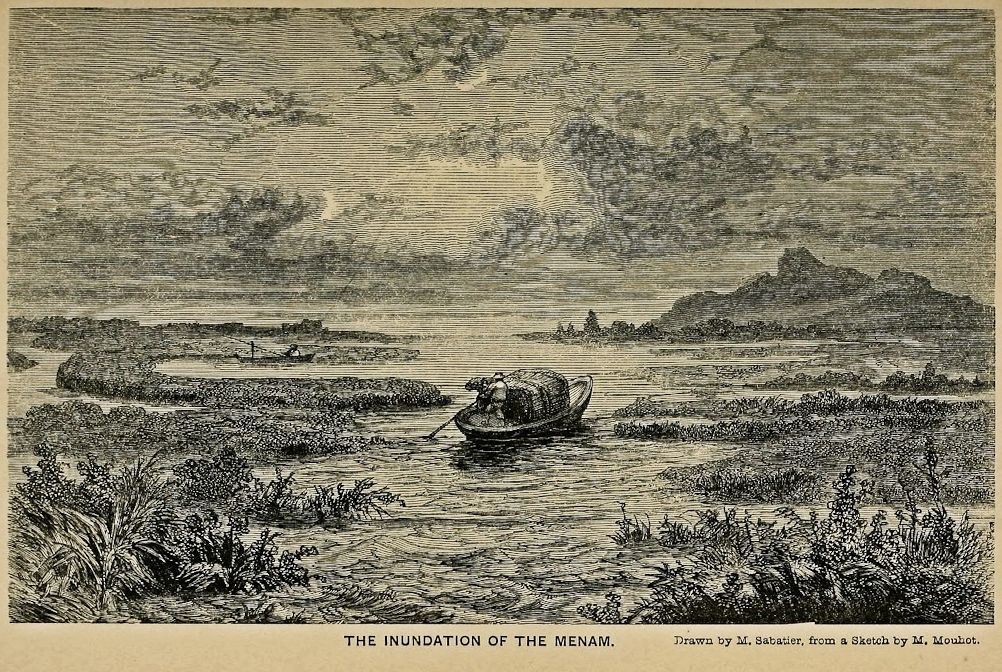
Abb.:
Überschwemmung des Chao Phraya (แม่น้ำเจ้าพระยา)
[a.a.O., Bd. I, S. 107]
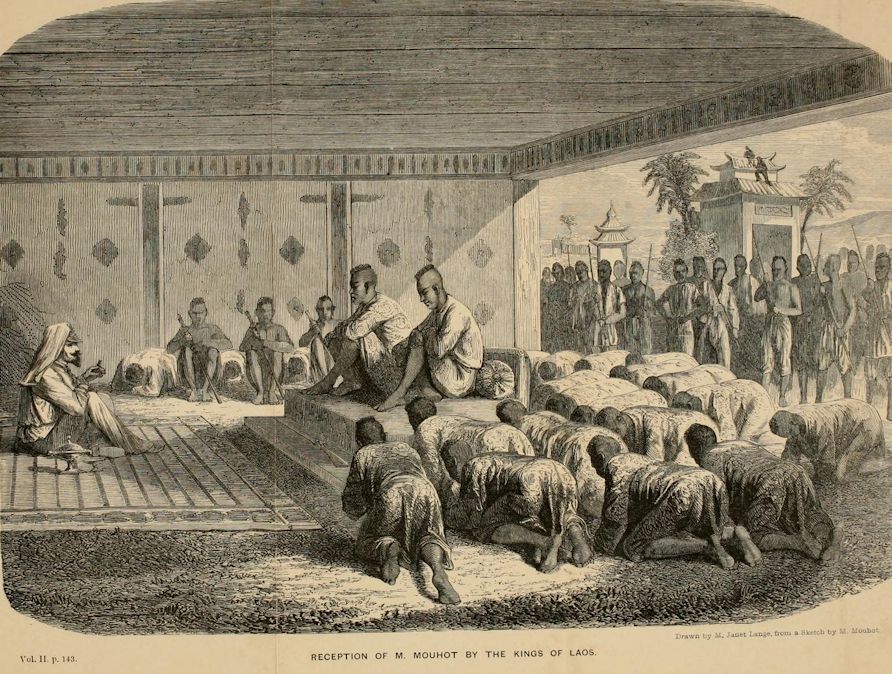
Abb.: Empfang
Mouhots durch die Könige von Laos
[a.a.O., Bd. II, vor S. 143]
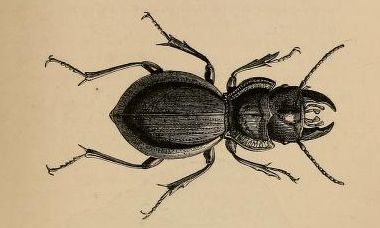
Abb.:
Mouhotia gloriosa Castelnau, 1862, von Mouhot in Laos entdeckter Käfer
[a.a.O., Bd. II, S. 183]
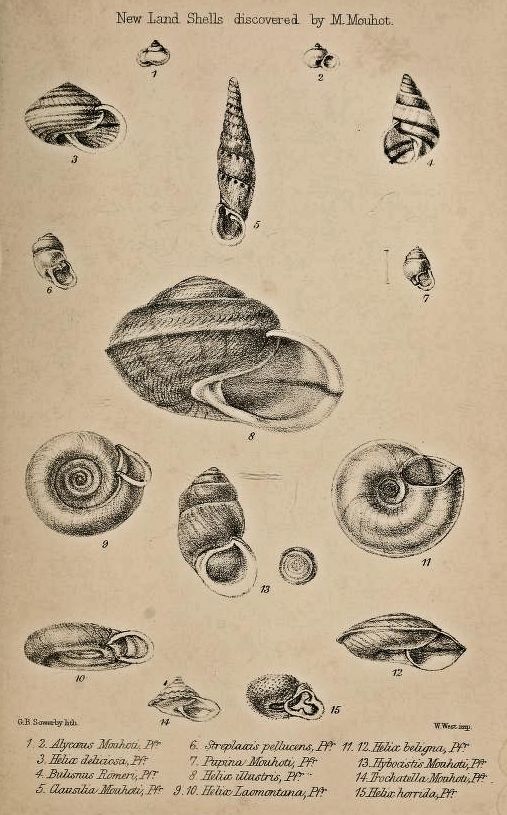
Abb.: Von Mouhot
entdeckte Landschnecken
[a.a.O., nach S. 186]
|
Alexandre Henri Mouhot (* 15. Mai 1826 in Montbéliard, Frankreich; † Oktober/November 1861 nahe Luang Prabang (ຫຼວງພະບາງ ) in Laos) war ein französischer Naturalist und Forschungsreisender. Er verließ am 27. April 1858 London, um Siam, Kambodscha und Laos zu bereisen. Im Januar 1860 erreichte er Angkor (អង្គរ), wo er eine ganze Reihe von Skizzen und Zeichnungen anfertigte. 1868 wurde postum der illustrierte Reisebericht Voyage à Siam et dans le Cambodge veröffentlicht, durch den die Tempel von Angkor erstmals die Aufmerksamkeit der breiten Öffentlichkeit in Europa auf sich zogen. Mouhot wird oft als der Entdecker Angkors genannt, ein Anspruch, den er selbst nie stellte und der nicht den Tatsachen entspricht, da bereits im 16. Jahrhundert portugiesische Reisende den Ort erreicht hatten und auch einige Missionare schon vor ihm dort gewesen waren. In seinem Buch zitierte er selbst ausdrücklich aus dem Bericht des französischen Missionars Charles-Emile Bouvillevaux, der bereits Jahre vor ihm die Tempel besucht und davon berichtet hatte. Die Khmer wussten immer von der Existenz der alten Tempel und benutzten einige, wie Angkor Wat, zu allen Zeiten für religiöse Riten. Mouhot starb an Malaria, als er die Gegend von Luang Prabang erkundete. Als der französische Konsul Auguste Pavie (1847 - 1925) 1887 auf seinen schlecht erhaltenen Grabstein stieß, ließ er an derselben Stelle am Ufer des Nam Khan nahe der Stadt einen neuen Grabstein errichten. Dieser wurde erst 1990 im Dschungel wiederentdeckt." [Quelle: http://de.wikipedia.org/wiki/Henri_Mouhot. -- Zugriff am 2013-02-05] |
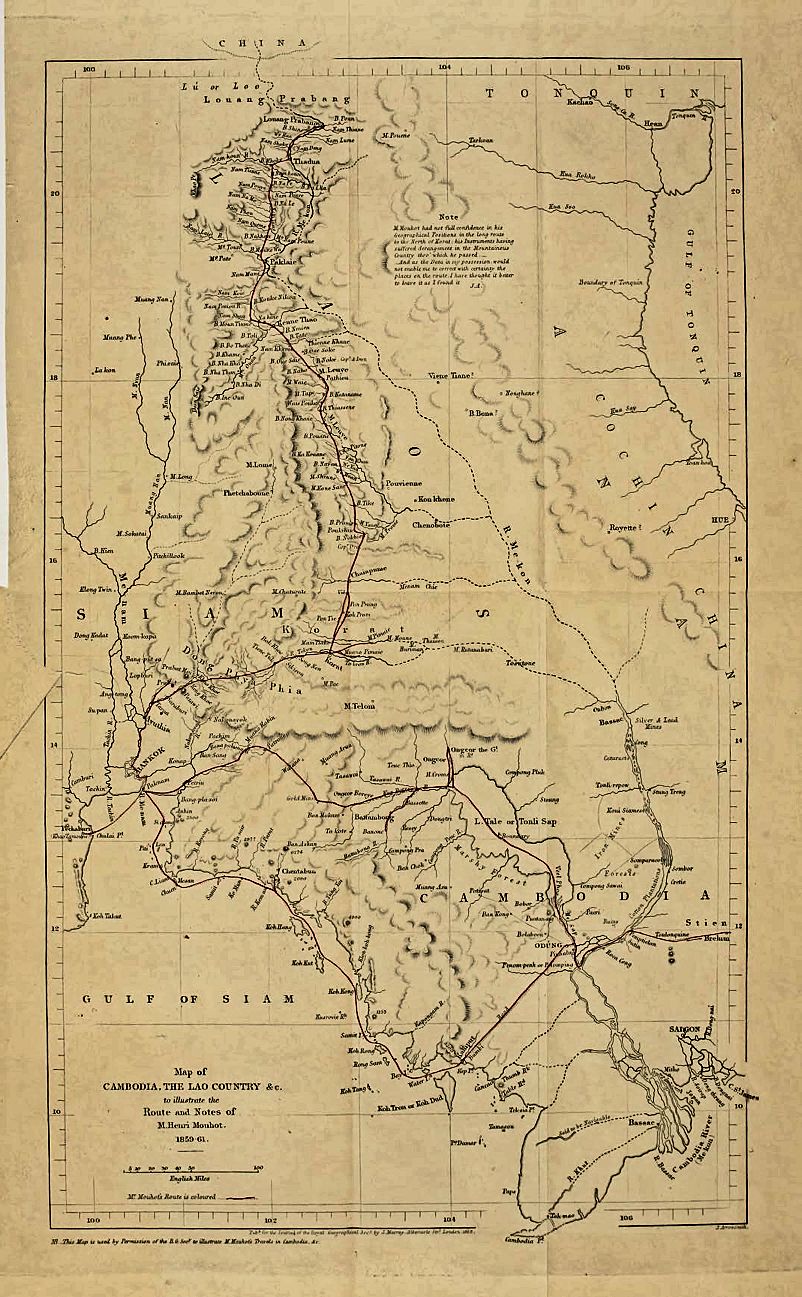
Abb.:
Reiseroute Mouhots
[a.a.O., Bd. II, nach S. 301]
1864

Es erscheintFrancis, G. [= Garnier, Francis] <1839 - 1873>: La Cochinchine française en 1864. -- Paris : Dentu, 1864. -- 48 S.
Abb.: Mort de Francis Garnier á Hanoi, Décembre 1873
[Bildquelle: Le explorateurs cèlèbres]
"D’ailleurs, en considérant la question à un point de vue plus élevé, un pays comme la France, quand il pose le pied sur une terre étrangère et barbare, doit-il se proposer exclusivement pour but l’extension de son commerce et se contenter de ce mobile unique, l’appât du gain ? — Celte nation généreuse dont l’opinion régit l’Europe civilisée et dont les idées ont conquis le monde, a reçu de la Providence une plus haute mission, celle de l'émancipation, de l’appel à la lumière et à la liberté des races et des peuples encore esclaves de l’ignorance et du despotisme. Eteindra-t-elle en ses mains le flambeau de la civilisation vis-à- vis de ces ténèbres profondes de l’Annam? fermera-t-elle les yeux devant cette misère immense? renoncera-t-elle à la plus belle partie de son œuvre? et, subissant la fatalité de la position qu’elle se sera faite, au lieu de régénérer les populations, en arrivera-t-elle comme l’Angleterre à ne se servir de scs armes que pour les forcer à accepter l’empoisonnement de l’opium? On voit qu’ici notre dignité et notre intérêt sont d’accord et repoussent également toute idée d’amoindrissement de notre puissance dans l’Annam."
[a.a.O., S. 44f.]
1864

Es erscheint:
Abel, M. H. [= Rieunier, Henri Adrien, Barthélemy, Louis] <1833 - 1918>: Solution pratique de la question de Cochinchine; ou, Fondation de la politique française dans l'Extrême-Orient. -- Paris : Ainè, 1864. -- 24 S.
Abb.: L'Amiral Rieunier
[Bildquelle: Le petit journal : supplement illustrée. -- 1892-10-01]
"Since the last distant expeditions, France can dream of again finding overseas not only the activity necessary to its commerce, for the development of its industry and the creation of outlets for the future, but it can also begin again the noble civilizing mission that has always given it such a high place in the world." [Übersetzt in: Osborne, Milton E.: The French presence in Cochinchina and Cambodia : rule and response (1859-1905). -- Bangkok : white Lotus, 1997. -- 379 S. : Ill. ; 20 cm. -- ISBN 974-8434-00-1. -- "First published by Cornell Univ. in 1969". -- S. 41]
1864

Es erscheint:
Paravey, Charles Hippolyte de <1787 - 1871>: Du royaume fort riche de Tchin-La ou du Cambodge, près Saïgon, et de l'importance de son occupation. -- Paris : Donnaud, 1864
1864

Es erscheint die erste Nummer von:
Le Courrier de Saigon : Journal officiel de la Cochinchine française. -- Saigon
1864 ff.

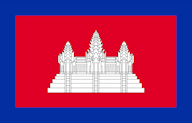
"One man most frequently embroiled in such court cases at the time was Phnom Penh’s foremost European merchant, Paul Le Faucheur. In de Lagrée’s [Leutnant Ernest Doudart de Lagrée (1823 - 1868), französischer Repräsentant in Kambodscha] first year in office, Le Faucheur was allegedly involved in two major incidents. During a planned excursion to Laos along the Upper Mekong, a local governor refused Le Faucheur passage without a proper Siamese passport. Displeased by the governor’s resistance, Le Faucheur allegedly fired his shotguns onto villagers, raped two of the governor's daughters, and incited his companions to ransack the village and rob the inhabitants of their belongings. Le Faucheur denied these allegations repeatedly, and it appears that the evidence unearthed by subsequent investigations remained insufficient to try him for the crimes. In the second case, Le Faucheur was accused of bullying a group of workers in the service of the Catholic mission of Ponhea Lu [ស្រុកពញ្ញាឮ] who had been sent by missionaries to cut bamboo along the Mekong River near Chhlong [ស្រុកឆ្លូង], where Le Faucheur was building a sawmill. Le Faucheur was said to have commandeered their labor while forcibly recruiting local inhabitants to work at his mill. Subsequent hearings organized by the French authorities were filled with contradictory testimonies concerning physical violence, verbal abuse, threats, and unpaid salaries. The facts were sufficiently complicated and obscure to keep Doudart de Lagrée from reaching a conclusive verdict.
The charges of rape, lingering over Le Faucheur’s head since his excursion to Stung Treng [ខេត្តស្ទឹងត្រែង], were reasserted three years later when he was accused of abusing an underage girl in the premises of the Queen Mother in the former palace at Oudong [ឧដុង្គ]. This time, the new representative carried out a thorough investigation, interviewing both the victim and witnesses at the location where the alleged crime had occurred. Once again, however, the evidence remained inconclusive. While it could be established that the girl was likely to be underage and was indeed bleeding when released by Le Faucheur, in her testimony she denied having been raped. It was also alleged that she had obtained payment for sexual favors in other instances, and that it was such an arrangement that had been the basis of her encounter with Le Faucheur. These insinuations were apparently sufficient to outweigh her status as a minor or any bruises that she may have had; the case was dismissed."
[Quelle: Muller, Gregor [= Müller, Gregor] <1968 - >: Colonial Cambodia's 'bad Frenchmen' : the rise of French rule and the life of Thomas Caraman, 1840-87. -- London : Routledge, 2006. -- 294 S. : Ill. ; 23 cm. -- (Routledge studies in the modern history of Asia ; 37). -- ISBN 978-0-415-54553-2 . -- S. 103. -- Fair use]
1864

Der katholische US-Autor T. W. M. Marshall über die protestantischen Missionare in Siam:
| "And then he [Neale] gives some account of the
Protestant missionaries, to the number of " seven or eight, and their
families," located on the two banks of the river near Bangkok. " The
missionaries on one side were at warfare with those on the opposite bank
regarding certain points of Church doctrine ; but as they were all
supported by one society, they were compelled to have a board meeting
once a month, to draw up reports, and send in their drafts for monthly
pay." Captain Laplace also remarked during his stay in this country, that " the missionaries established in Siam are chiefly occupied in disputing with one another, and condemning each other to eternal fire." [Quelle: Marshall, T. W. M. (Thomas William M.) <1818-1877>: Christian missions : their agents, and their results. -- New York : Sadlier, 1864. -- Bd. 1, S. 161] |
1864-01-12 - 1869-01-12
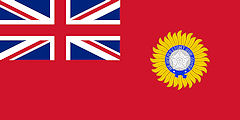
Sir John Lawrence (1811 - 1879) ist Governor-General and Viceroy of India
1864-01-23


Siam lässt durch seinen Konsul in Paris, Amédée Gréhan (1812 - 1879), dem französischen Außenministerium eine Chronique abrégée du Cambodge vorlegen, um die Ansprüche Siams auf Kambodscha zu belegen.
1864-02-02


Der französische Repräsentant in Kambodscha, Leutnant Ernest Doudart de Lagrée (1823 - 1868), teilt dem kambodschanischen Hof mit, dass Frankreich den Protektoratsvertrag vom 1863-08-11 ratifiziert hat. Unter dem Druck Siams entscheidet sich König Norodom I (ព្រះបាទនរោត្តម) (1834–1904), nach Bangkok zu reisen, um dort gekrönt zu werden. Er informiert Lagrée von diesem Vorhaben. Lagrée droht ihm für diesen Fall mit Konsequenzen.
1864-03-03 - 1864-04-12


Ein siamesisches Marinegeschwader soll König Norodom I (ព្រះបាទនរោត្តម) (1834–1904) von Kambodscha in der kambodschanischen Hauptstadt Udong (ឧដុង្គ) zur Krönung nach Bangkok abholen. Der Französische Repräsentant, Leutnant Ernest Doudart de Lagrée (1823 - 1868), lässt aus Saigon 2 Kanonenboote und 150 Soldaten kommen, besetzt den Königspalast und hießt die französische Flagge unter Salutschüssen. Erschreckt kehrt Norodom in den Plast zurück und erklärt sich 1m 1864-04-12 bereit, den Protektoratsvertrag mit Frankreich vom 1863-08-11 (siehe dort) zu ratifizieren. Siam stimmt zu, Norodom in Udong zu krönen im Beisein von Vertretern Frankreichs.
Abb.: Lage von Udong (ឧដុង្គ) und Kampot (កំពត)
[Bildquelle: Scottish Geographical Magazine. -- 1886. -- Public domain]
1864-03-17
Eröffnung der New Road (Thanon Charoen Krung - ถนนเจริญกรุง) in Bangkok.
Abb.: Lage der New Road (Thanon Charoen Krung - ถนนเจริญกรุง)
[Bildquelle: OpenStreetMap. -- Creative Commons Lizenz (Namensnennung, share alike)]
Abb.: Thanon Charoen Krung - ถนนเจริญกรุง
[Bildquelle: th.Wikipedia. -- Public domain]
1864-05-01

Eröffnung der Protestant Union Chapel (aka English Church) in der Charoen Krung Road (ถนนเจริญกรุง), Bangkok.
"Until the year 1864 the Protestants in Bangkok had to assemble for Divine service in one of the houses of the American missionaries. A meeting was held at the British Consulate in 1863, and a memorial was drawn up soliciting the King of Siam to grant a piece of land for the erection of a Protestant church. The king at once graciously gave the fee simple of a convenient site on the river bank. The British residents then collected £300, and the Foreign Office granted £400 on the understanding that the care and management of the church should be vested in the British Legation. The church was built in 1864, and was known as the Protestant Union Chapel. No regular chaplain was appointed, consequently the services were conducted by one of the American missionaries. In the year 1894 it was decided that in future the service should be in accordance with the rites of the Church of England, and that a permanent chaplain should be appointed. Accordingly the same year Canon Wm. Greenstock, M.A., was appointed chaplain. With the exception of the Rev. Mr. Green, who was tutor to the late Crown Prince, and who officiated for some time in the Union Chapel, Canon Greenstock was the first Episcopal clergyman who entered Siam. On February 16, 1896 the Right Rev. George Hose, D.D., Bishop of Singapore, came to Bangkok at the request of Canon Greenstock, and held a confirmation. Canon Greenstock resigned in 1901, when he became a missionary in Bangkok under the Society for the Propagation of the Gospel in Foreign Parts—an appointment which he still holds."
[Quelle: Hernry J. Hillyard in: Twentieth century impressions of Siam : its history, people, commerce, industries, and resources / ed. in chief: Arnold Wright. -- London [etc.] : Lloyds, 1908. -- S. 217]
1864-05-27


Brief von Rama IV. an Her Majesty Victoria, by the Grace of God, of the United Kingdom of Great Britain and Ireland Queen, Defender of the Faith (1819 - 1901)
"Somdetch Phra Paramendr Maha Mongkut by the Divine blessing of the Superagency of the Universe, the first King of Siam, and its dependencies, great parts of Laos, Cambodia, several provinces of the Malayan Peninsula &c. &c. &c. To
Her Most Gracious Majesty Victoria,
Queen of the United Kingdom of Great Britain and Ireland, Sovereign of Hindostan, Defender of the Faith, &c. &c. &c.Our royal Sister and most distinguished and respected friend,
Humbly and respectfully sendeth greeting.
Please permit us to acquaint Your gracious Majesty, that your Majesty’s faithful consul, Sir Robert Schomburgk [1804 - 1865], whom Your Majesty in Council was pleased to nominate as consul at Bangkok, on his arrival here in the year of the serpent, ninth decade of the Siamese local Era 1219, corresponding to the Christian year 1857, was the bearer of Your Majesty’s Royal letter and certain royal gifts to cement the friendship between us and Your Majesty.
The subject of Your Majesty’s letter was introductory of Sir Robert Schomburgk in order that we might become familiarly acquainted with him.
Sir Robert Schomburgk has now been in Bangkok over six years, and has, on all occasions, endeavoured faithfully and zealously to fulfil his duties as the servant of Your Majesty.
He has also by his good qualities greatly pleased our Ministers, who have expressed their satisfaction with his conduct as consul, in a letter sent in his charge for the information of Your Majesty’s Ministers.
Sir Robert Schomburgk is about the same age as ourselves, being only three months older. As he is now sixty years of age, he feels himself unable to withstand the effect of our warm climate, and has taken leave to return to Europe, where the climate is more salubrious.
We could not allow Sir Robert Schomburgk to depart without our royal letter which we have to send in his charge, and as he has resigned his appointment as Your Majesty’s consul at Siam, we would beg Your Majesty that you will still continue to extend Your royal favour to him. We would beg Your Majesty will be graciously pleased to direct Your Ministers to select a person of rank and possessing the like good qualities as Sir Robert Schomburgk to be appointed in the place of Sir Robert Schomburgk without delay. We also beg that the new Consul at Siam may be a person of intelligence and well acquainted with his duties. We would prefer a person sent direct from England, and whose good qualities and abilities the British Government is aware of from personal acquaintance.
If the new consul be a person familiar with the international and other laws, he would render great assistance to the Siamese Government, who are in governing of a powerless nation, by advising and conferring with it in matters of importance, and thereby ward off any calamities which might otherwise befall us through misunderstanding with the neighbouring great powers.
From the South West extending to the North West of Siam, since the last 40 years, the frontiers of Great Britain certain disputes have joined those of this kingdom, different understanding on trifling matters have sometimes taken place between the two governments, but through the medium of Your Majesty’s consul here, all these differences have been nearly all satisfactorily arranged: those that remain unsettled are but a few unimportant ones.
The Siamese Government is aware that it is distant from Europe and that it is unacquainted with the good laws and custom[s] of civilized Europe. The Siamese Government have consequently been willing that Your Majesty with the Ministers should decide on all such differences, as it has been confident that the decree of the British parliament would always be guided by justice. We consider ourselves as closely connected with Great Britain for the following three reasons.
- 1st Our territories have for a long period past, bordered on those of Great Britain, as we have above stated.
- 2nd A treaty was concluded many years ago and was renewed before any other nation made one with Siam.
- 3rd Besides the treaty Royal, letters have passed between Your Majesty and ourselves, the Siamese ministers and those of Great Britain have corresponded, these correspondences have been mutually read and understood without the necessity of the interposition of an interpreter
For these reasons we beg Your Majesty will bestow your compassion and favour on us.
Sometime since, we and our Ministers were desirous of nominating a Siamese consul at London, and we requested Sir Robert Schomburgk to inform Your Majesty’s ministers of our intention. A reply was received giving their consent which pleased us much. We then selected Mr. D. K. Mason a British subject who had resided in Siam for eight years as merchant and had become acquainted with the customs of Siam, and who having many friends in London was desirous of returning to live there in an honorable position.
We informed Sir Robert Schomburgk who expressed to us his approbation of our choice; we therefore appointed Mr. D. K. Mason as our consul and conferred on him the title according to the Siamese custom of “Phra Siam Dhurabah. ” Sir Robert Schomburgk assured us that Your Majesty’s Government would recognise the appointment.
I would beg Your Majesty will extend your favour and benevolence towards Mr. D. K. Mason our consul.We were sincerely grieved to learn of the decease of Your Majesty's royal mother, and of Your Majesty’s royal consort, which two sad events happened on the last year
We sincerely sympathize with Your Majesty’s unrepairable losses, nevertheless, we trust that Your Majesty will find consolation in the thought that all mankind must follow this path, even those most dear to us cannot be prevented from leaving us.We ourselves have also within the last three years suffered losses in our royal family, by the death of our royal queen consort aged 27 years, of our second son aged 38 years, and of our daughter aged 8 years. These matters are all known unto Sir Robert Schomburgk.
We must now beg to express our pleasure and congratulations at learning that Your Majesty’s royal family has been increased by the birth of royal grandchildren. We sincerely trust that they may long remain and will prove a source of happiness to Your Majesty.
We pray the Superagency of the Universe may pour his Divine blessing on Your Majesty and render you every happiness and a long and prosperous life and reign, and that the friendship between our two nations may be happily connected until the end of time.
Given at our Royal Court House Anant Samagome [พระที่นั่งอนันตสมาคม], Grand Palace Ratne Kosind Mahindr Ayudia [รัตนโกสินทร์ มหินทรายุธยา] Bangkok on Friday the 7th night of the Lunar month of Bisakh [พิสาข], which is the 6 th month from commencement of cold season in the year of Mice [ชวด] sixth decade of Siamese local Era 1226, corresponding to the 27th day of the month of May in Anno Christ’s 1864, which is the 14th year or 4762nd day of our reign.
All above lines are the Respectfully Homage from Your Gracious Majesty’s most obedient faithful Manu Regnia humble Servant honoured by Your Gracious Majesty as Your Majesty’s affectioned Royal Brother and distinguished friend.
(Sd. ) S. P. P. Mongkut Rex Siamensium."
[Zitiert in: Cœdès, George <1886 - 1969>: English correspondence of King Mongkut. -- In: Journal of the Siam Society. -- 22,1 (1928). -- S. 14 - 17]
1864-06-03


Krönung von König Norodom I (ព្រះបាទនរោត្តម) von Kambodscha (Februar 1834 – 24. April 1904) gemeinsam durch Siam und Frankreich: der König von Siam ernennt ihn zum König, der Repräsentant Frankreichs übergibt ihm die Krone. Norodom ist begeistert.
Titel Norodoms:
"Grand King with divine feet, superior to anyone, descendant of the deities and of Vishnu..., of supreme power on earth, full of qualities like the sun ..., great among the great, the one whose power extends over the whole of Cambodia . .., grand King whose power has no limits." [Quelle: Muller, Gregor [= Müller, Gregor] <1968 - >: Colonial Cambodia's 'bad Frenchmen' : the rise of French rule and the life of Thomas Caraman, 1840-87. -- London : Routledge, 2006. -- 294 S. : Ill. ; 23 cm. -- (Routledge studies in the modern history of Asia ; 37). -- ISBN 978-0-415-54553-2. -- S. 75]
Abb.: Münze mit Portrait von Norodom I (ព្រះបាទនរោត្តម) : deux francs 1860
[Bildquelle: Pyvanet / Wikimedia. -- Public domain]
1864-07-21

Die chinesische Armee erobert Nanjing, die Hochburg des Himmlischen Taiping-Königreichs (太平天囯). Damit ist die seit 1851 andauernde Taiping-Revolution (太平天国) niedergeschlagen und die Herrschaft der Qing-Dynastie (清朝) in China gesichert.
Abb.: Größte Ausdehnung des Himmlischen Taiping-Königreichs (太平天囯) 1854
[Bildquelle: Zolo / Wikipedia. -- GNU FDLicense]
1864-08-22
Genf (Schweiz): 16 Staaten unterzeichnen die Konvention zur Verbesserung des Loses der verwundeten Soldaten der Armeen im Felde (Genfer Konvention). Auch das Logo "Rotes Kreuz" wird beschlossen
Abb.: Genfer Konvention 1864
[Bildquelle: Kevin T. Quinn. -- http://www.flickr.com/photos/kevinq2000/22585719/. -- Zugriff am 2013-05-31. -- Creative Commons Lizenz (Namensnennung)]
1864-09-28
London: Gründung der ersten Internationale (International Workingmen's Association - IWA) (1864 - 1876)
Abb.: Plakat
1864-10-18 - 1864-10-20

Ramas IV. 60. Geburtstag (5 x 12 Jahre) wird mit großem Pomp gefeiert.
"October 18, 1864, was "the Major King’s 60th birthday, and he made a great ado to have it universally observed and it was so, being anticipated two days and extending to the 20th. Almost all the houses on the river and vessels were splendidly illumined three nights. The party of Europeans and Americans at the King’s palace was large and the dining table well furnished. But the King in his extraordinary efforts to honor the Consuls, greatly offended the merchants who rose en masse after they had taken their soup and left the place. It appeared that the King did not design to slight them but being absorbed in his attentions to the Consuls forgot the merchants until it was too late to correct the mistake. It produced a great confusion all around so that the Consuls not even enjoyed their dinner and the King felt quite sad about it." [Dan Beach Bradley (1804 - 1873). -- Zitiert in: Moffat, Abbot Low <1901 - 1996>: Mongkut, the king of Siam. -- Ithaca N.Y. : Cornell UP, 1961. -- S. 99f.]
1864-12-17

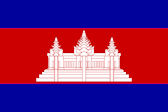
Abb.: Der König von Kambodscha bei einem Besuch in Saigon. -- In: Le Monde illustré <Paris, Frankreich>. -- No 401. -- 1864-12-17. -- Titelblatt
1864-12-31 - 1865-07
Verbot, Reis aus Siam zu exportieren, da die Reisernte sehr gering ist. Im Hafen von Bangkok liegen Hunderte von Schiffen, die Reis exportieren sollten.
ausführlich: http://www.payer.de/thailandchronik/ressourcen.htm
Moffat, Abbot Low <1901 - 1996>: Mongkut, the king of Siam. -- Ithaca N.Y. : Cornell UP, 1961. --254 S. : Ill. ; 23 cm.
Blofeld, John <1913 - 1987>: King Maha Mongkut of Siam. -- 2. ed. -- Bangkok : Siam Society, 1987. -- 97 S. : Ill. ; 22 cm.
Chula Chakrabongse [จุลจักรพงษ์] <1908 - 1963>: Lords of life : History of the Kings of Thailand. -- 2., rev. ed. -- London : Redman, 1967. -- 352 S. : Ill. ; 22 cm.
Phongpaichit, Pasuk <ผาสุก พงษ์ไพจิตร, 1946 - > ; Baker, Chris <1948 - >: Thailand : economy and politics. -- Selangor : Oxford Univ. Pr., 1995. -- 449 S. ; 23 cm. -- ISBN 983-56-0024-4. -- Beste Geschichte des modernen Thailand.
Terwiel, Barend Jan <1941 - >: A history of modern Thailand 1767 - 1942. -- St. Lucia [u. a.] : Univ. of Queensland Press, 1983. -- 379 S. ; 22 cm.
Ingram, James C.: Economic change in Thailand 1850 - 1870. -- Stanford : Stanford Univ. Pr., 1971. -- 352 S. ; 23 cm. -- "A new edition of Economic change in Thailand since 1850 with two new chapters on developments since 1950". -- Grundlegend.
Akira, Suehiro [末廣昭] <1951 - >: Capital accumulation in Thailand 1855 - 1985. -- Tokyo : Centre for East Asian Cultural Studies, ©1989. -- 427 S. ; 23 cm. -- ISBN 4896561058. -- Grundlegend.
Skinner, William <1925 - 2008>: Chinese society in Thailand : an analytical history. -- Ithaca, NY : Cornell Univ. Press, 1957. -- 459 S. ; 24 cm. -- Grundlegend.
Simona Somsri Bunarunraksa [ซีมอนา สมศรี บุญอรุณรักษา]: Monseigneur Jean-Baptiste Pallegoix : ami du roi du Siam, imprimeur et écrivain (1805 - 1862). -- Paris : L'Harmattan, 2013. -- 316 S. : Ill. ; 24 cm. -- (Chemins de la mémoire ; Novelle série). -- ISBN 978-2-336-29049
Morgan, Susan <1943 - >: Bombay Anna : the real story and remarkable adventures of the King and I governess. -- Berkeley [u.a.] : Univ. of California Press, 2008. -- 274 S. : Ill. ; 23 cm. -- ISBN 978-0-520-26163-1
ศกดา ศิริพันธุ์ = Sakda Siripant: พระบาทสมเด็จพระจุลจอมเกล้าเจ้าอยู่หัว พระบิดาแห่งการถ่ายภาพไทย = H.M. King Chulalongkorn : the father of Thai photography. -- กรุงเทพๆ : ด่านสุทธา, 2555 = 2012. -- 354 S. : Ill. ; 30 cm. -- ISBN 978-616-305-569-9
Lavery, Brian: Schiffe : 5000 Jahre Seefahrt. -- London [u. a.] : DK, 2005. -- S. 184. -- Originaltitel: Ship : 5000 years of marine adventure (2004)